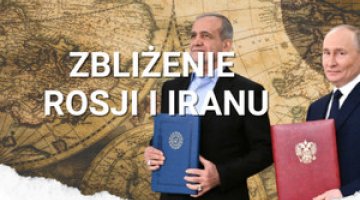A new Russian-Iranian treaty: closing ranks ahead of Trump’s presidency
On 17 January, the leaders of Russia and Iran, Vladimir Putin and Masoud Pezeshkian, signed an interstate treaty in Moscow, replacing an agreement from 2001. The document is primarily intended to reflect the evolving nature of relations between the two countries, which have drawn significantly closer over the past decade, particularly following Russia’s invasion of Ukraine. This shift is symbolised by the treaty’s title, which refers to their ties as a “comprehensive strategic partnership”.
While the treaty outlines areas for deeper cooperation in broader and in more detailed terms than its predecessor, it does not, unlike Russia’s recent agreement with North Korea, establish allied commitments in the area of security and defence. Instead, it should be regarded as a political statement primarily aimed at bolstering the position of both regimes in their dealings with the new administration in Washington.
Intensifying cooperation
Since the 1990s, Iran has been one of Russia’s key partners in the Middle East. Initially, their cooperation focused on the energy sector. Its most notable outcome was the construction of the Bushehr nuclear power plant by Russia’s Atomstroyexport under a contract signed in 1995, which was revised in 2006 under US pressure. The plant’s first unit was commissioned in 2011. Since Moscow’s relations with the West deteriorated following Russia’s 2014 annexation of Crimea and military intervention in eastern Ukraine, Russia and Iran have drawn closer. In 2014, the two countries signed a contract for the construction of the second and third units at the Bushehr plant, with the first of these becoming operational in October 2024.
The two regimes have cooperated even more closely in the political, diplomatic, and military spheres. Their collaboration in Syria, where Russia deployed expeditionary forces in the autumn of 2015 to support the regime of Bashar al-Assad, played a major role in this process. This intervention bolstered Shia militias fighting on Assad’s side under the command of Iranian officers from the Islamic Revolutionary Guard Corps. A symbolic turning point in bilateral relations came in 2016, when Russia delivered S-300 air defence systems to Iran, reversing its 2010 decision to suspend the delivery in an effort to mend ties with the US.
Russian-Iranian relations intensified further following Russia’s full-scale invasion of Ukraine in February 2022. Iran is one of the key countries with which Russia has strengthened contacts both at the highest and ministerial levels. In one measure of the Kremlin’s growing trust in Tehran, Iran joined the small group of countries that Putin personally visited after the outbreak of the full-scale war, which also included China and three Arab states (in addition to Belarus and Central Asian nations).
Military-technical cooperation has also grown significantly. Alongside North Korea, Iran is the only country to have supplied Russia with military equipment for its war in Ukraine, primarily in the form of combat drones, the production of which was partially relocated to Russia in the summer of 2023. Deliveries of advanced aviation technology, particularly the latest Su-35 fighter jets, which have previously been exported only to China, appear to be part of Russia’s manoeuvring vis-a-vis Tehran and Washington. Iran has been preparing to receive the aircraft but, in December 2024, denied unconfirmed reports of the delivery of the first two jets. Moreover, the two countries have held regular meetings between their defence ministers, national security secretaries and senior military officials, as well as joint naval exercises with China in the Persian Gulf and the Indian Ocean.
The treaty as an anti-American statement
The new treaty serves as a political statement and reflects the gradual strengthening of Russian-Iranian relations in recent years. According to Iranian sources, Tehran first proposed the treaty in 2019 and then submitted a draft to Moscow in July 2023. The signing of the document was announced several times but repeatedly postponed, revealing difficult negotiations, significant differences over proposed changes and underlying distrust between the two partners.
The timing of the treaty’s signing, just three days before Donald Trump’s inauguration as President of the United States, suggests that one of its primary objectives was to strengthen both countries’ position in relation to Washington. The new administration is expected to adopt a tougher US policy towards Iran, increasing the likelihood of a US military strike aimed at destroying Iran’s nuclear facilities linked to its nuclear weapons programme.
In this context, Iran’s move towards closer military ties with Russia, even without a clause on mutual assistance in the event of armed conflict, aims to reduce the risk of a US or Israeli attack. For Russia, showcasing its close relationship with Iran, a country that the new White House administration views as America’s second-biggest adversary after China, and signalling its willingness to deepen this partnership further, should be seen as part of its bargaining strategy ahead of negotiations on Ukraine. In this way, Russia hopes to pressure the new US administration into concessions that would encourage restraint in how the treaty’s provisions are implemented in practice. This also suggests that Russia intends to adopt a tough stance in its negotiations with the Trump administration, aiming to achieve maximum objectives with regard to Ukraine and the West. Furthermore, it demonstrates that Moscow is prepared to engage in a ‘test of strength’ with Washington.
The treaty’s contents: prioritising security and defence
The new treaty differs from the 2001 agreement mainly in its explicit articulation of the ideological foundation for Russian-Iranian cooperation, which is based on supporting the “objective” process of establishing a new multipolar international order while rejecting unipolarity and hegemony in global politics. The treaty also emphasises the purported “closeness of cultures and spiritual-moral values” as the basis for the bilateral relationship.
Unlike the previous treaty, the new agreement explicitly prioritises security and defence as the primary areas where the two partners aim to “deepen and expand” their cooperation. It specifically highlights collaboration between their intelligence and security services, armed forces (including joint exercises and other forms of military cooperation), cooperation in the military-technical sphere and efforts to maintain internal order and security. Additionally, the document envisions consultations and cooperation in countering common military and security threats.
Unlike the agreement that Russia signed with North Korea in 2024, the Russian-Iranian treaty does not provide for mutual assistance in the event of aggression. Similar to the 2001 Russian-Iranian treaty, it only commits both parties to refrain from aiding an aggressor and to work towards resolving conflicts based on UN norms and international law. However, the new document omits the provision requiring obligatory consultations to consider measures for addressing threats to peace and security.
Several of the treaty’s provisions outline cooperation on issues broadly related to information security and cybersecurity. The parties pledge mutual support in their global efforts to promote the principle of national sovereignty over the Internet and regulate it through international frameworks.
The priorities for economic cooperation
The treaty envisions cooperation across all possible areas, primarily the economy (including energy) and transport, with a focus on developing the North-South Transport Corridor. It also includes provisions for cooperation in science, culture, environmental protection, healthcare, and other fields. However, this document is a framework agreement, meaning that further development of cooperation in all these areas will require the two sides to conclude specific agreements and contracts. Notably, during President Pezeshkian’s visit to Moscow, no additional agreements were signed to implement the treaty’s stated intentions of intensifying and deepening relations.
Thus far, Russian-Iranian relations have been characterised by a growing asymmetry between declarations of political partnership and shared interests, the intensity of political contacts, and the depth of cooperation in selected areas (such as nuclear energy and, to some extent, military affairs) on one hand, and the difficulties in advancing practical collaboration in other sectors on the other. This is most evident in trade and transport, two areas where both sides have clear shared interests.
Trade volumes have been increasing (by 15% in the first ten months of 2024) but reached only around $2.5 billion in 2023. The construction of the Astara–Rasht railway line, intended to eliminate the main bottleneck in the priority infrastructure project to develop the North-South Transport Corridor, has yet to begin. This remains the case despite the announcement in May 2024 of a supposedly final agreement after years of protracted negotiations, with Russia allocating a €1.6 billion loan for the project. Similarly, talks aimed at enabling the use of Russian bank cards in Iran and Iranian cards in Russia have been dragging on for years without resolution. The fate of the gas pipeline project announced last year, which would facilitate Russian gas exports to Iran, also remains uncertain.
Outlook: more of the same
Russian-Iranian cooperation intensified while the 2001 treaty was still in force. The signing of the new agreement is unlikely to alter the situation in any significant way or address the persistent challenges in implementing a number of arrangements, which appear to stem from structural issues. These challenges include Iran’s distrust and suspicion of Russia, the incompatibility of their similarly structured economies, and difficulties caused by US sanctions, particularly in financial settlements.
Despite the treaty’s declared partnership based on shared values, Russian-Iranian relations are unlikely to change in any fundamental way. They will continue to be characterised by a high degree of pragmatism and an instrumental approach to the partnership. The two regimes’ fundamental conflict with the West, especially the United States, will remain the foundation and driving force of their relationship.





